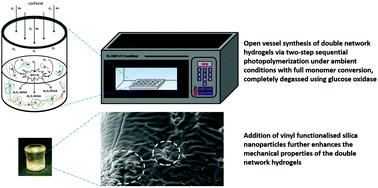Open vessel free radical photopolymerization of double network gels for biomaterial applications using glucose oxidase†
Abstract
Polymerization of certain gels in the presence of oxygen can lead to hindered reaction rates and low conversion rates, limiting the use of open vessel polymerization and material synthesis. Here, the oxido-reductase enzyme glucose oxidase (GOx) was used to enable open vessel free radical photopolymerization (FRP) of neutral polyacrylamide (PAAm), and polyelectrolyte poly(2-acrylamido-2-methyl-1-propanesulfonic acid) (PAMPS) under ambient conditions. GOx successfully blocks the inhibition pathways created by O2 in FRP, dramatically increasing the polymer conversion rate for both polymers. In the presence of GOx, PAAm and PAMPS achieved conversion of 78% and 100% respectively at a photoinitiator (PI) concentration of 0.05 wt% with GOx, compared to 0% without GOx at the same PI concentration. Cytotoxicity studies of these polymers show high cell viability after GOx is denatured. Double network hydrogels (DNHGs) were successfully produced using the polymers and use of GOx improved compressive fracture stress by a factor of ten. Vinyl functionalized silica nanoparticles (VSNPs) were used as cross linkers of the first network to further enhance the mechanical properties.

- This article is part of the themed collection: Journal of Materials Chemistry B Advisory Board Collection


 Please wait while we load your content...
Please wait while we load your content...